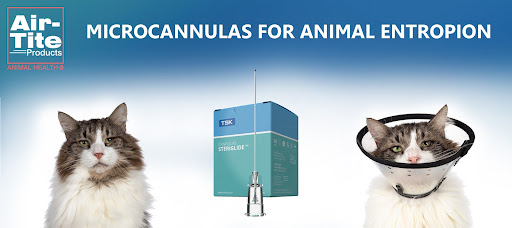
Entropion is an uncomfortable eyelid malformation where inward rolling affects the top or bottom eyelid. Symptoms range from mild irritation to ulceration and vision loss. While specific dog breeds are more prone to developmental (primary) entropion, any canine or feline can acquire entropion following an injury or infection.
Fortunately, surgical correction or subdermal fillers can reverse entropion-related complications and improve the quality of life for pets and their loved ones. Here’s why microcannulas are an excellent tool for animal entropion surgery.
Microcannulas are an increasingly popular alternative to traditional hypodermic needles. Unlike sharp, piercing needle tips, microcannulas are hollow tubes with blunt, rounded tips.
In addition, because microcannulas are made of flexible material, they offer a gentler approach to the desired injection site. Like needles, microcannulas are available in several sizes for various injections in superficial and more invasive procedures.
Microcannulas offer various benefits, making them a preferred option for several human and veterinary surgeons. In addition to requiring less injection points, the flexible tube allows greater maneuverability and control.
As a result, microcannulas are less likely to tear the epidermis and damage delicate blood vessels near the eyelids, producing fewer bruises and faster recovery times. Many surgeons find microcannulas also achieve a more widespread and even distribution of injectables for a more predictable and favorable operation.
A 2022 review of 40 veterinary cases (including 28 dogs and 12 cats) demonstrated the benefits of hyaluronic acid (HA) injections for mild to moderate entropion patients. Clinicians injected Restylane or Restylane Silk 1-2 mm from the affected eyelid margin to restore normal shape and function.
There were no significant complications, and most patients experienced relief right away. Entropion-related issues like blepharospasm, corneal ulceration, and epiphora are typically resolved within the first week of treatment. However, three of the dogs and one cat ultimately required entropion surgery.
Nonetheless, subdermal HA fillers offer a long-acting alternative for many canine and feline entropion cases. In addition, this method could be particularly useful in high-risk or geriatric patients with mild to moderate entropion as a minimally-invasive, safe, and predictable procedure.
One of our customers is a doctor of veterinary medicine who frequently purchases our TSK STERiGLIDE™ cannulas specifically for this procedure. He tends to order 22 and 25 gauge cannulas in 1-½” and 2” variations.
It’s often best to plan on a few follow-up procedures to avoid the risk of overcorrection (ectropion). During the initial surgery or subdermal filler injection, a major correction significantly reduces eyelid malformation and can offer immediate relief from discomfort. However, sometimes additional corrective visits ensure the best ultimate results.
Fortunately, the outlook for canine entropion patients is excellent, with success rates up to 95% after the first procedure. Providers can offer antibiotics and artificial tears pre-and post-operatively to help reduce complications and make patients more comfortable.
Offering minimally-invasive alternatives, when appropriate, individualizes treatment for each patient. The ability to fix entropion issues with a cannula allows for the animal to recover without stitches or many post-surgical irritants.
Air-Tite carries a variety of microcannulas, including TSK CSH cannulas - a lower cost, high quality cannula option. Click below to learn more.